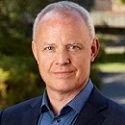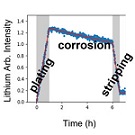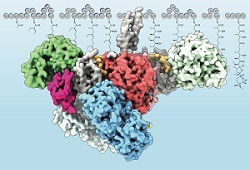
Holiday Message from the Director

As 2021 draws to a close, we want to express our thanks for your contributions to forefront science and technological development. We applaud everyone for doing their best to meet the challenges of the day, and our hearts go out to those who have suffered devastating losses.
Your support is appreciated as we move forward with the mission of our laboratory while continuing to keep safety as a priority. We wish you the very best during this holiday season. We hope the coming year will bring exciting new opportunities and a few less challenges.
– Paul McIntyre
Science Highlight

Quantification of Efficiency in Lithium Metal Negative Electrodes via Operando X-ray Diffraction – Contacts: Natalie Geise, Stanford University, and Johanna Nelson Weker, SSRL
Gasoline cars are able to travel further between fill-ups than electric cars before recharge, which is a limiting factor for the widespread adoption of electric vehicles and utilization of renewable energy sources for transportation. Improving the energy density of the batteries could solve this problem, so researchers are developing lithium metal batteries to replace lithium-ion batteries. Lithium metal batteries can hold more charge per volume. However, they are not as stable and degrade over time. A team of researchers has studied the ways that the lithium metal electrode material degrades to cause capacity loss. Read more...
More SSRL-Related News
Researchers Probe Secrets of Natural Antibiotic Assembly Lines
Excerpt from SLAC News Article

Every cell is a master builder, able to craft useful and structurally complex molecules, time and again and with astonishingly few mistakes. Scientists are keen to replicate this feat to build their own molecular factories, but first they will need to understand it.
“We have thousands of these assembly lines in nature, and they all make unique compounds,” said Dillon Cogan, a postdoctoral scholar in the lab of Stanford professor Chaitan Khosla. “The dream is to one day be able to recombine pieces from different assembly lines so that we can make useful compounds not found in nature. To do that, we need to know the design principles that make these things work.”
In two new papers recently published in Science, researchers used x-ray crystallography and cryogenic electron microscopy to reveal new details of the structure and function of molecular assembly lines that produce common antibiotics. Read more...
Citations:
Cogan et al., Science, 5 November 2021 (10.1126/science.abi8358)
Bagde et al., Science, 5 November 2021 (10.1126/science.abi8532)
SSRL Users' Executive Committee Update
SSRL UEC 2021-2022 Membership
Please join us in supporting Graham George as the new UEC Chair and Blaine Mooers as the Vice-Chair. We thank everyone who agreed to be nominated and extend a warm welcome to our newly elected member: Stefan Minasian.
We would like to acknowledge the continuing contributions of Eddie Snell, who rotates from SSRL UEC Chair to Past Chair. Finally, we would like to express our thanks to retiring committee member Michael Capano. For more information see SSRL's Users' Executive Committee (UEC).
Events
RapiData 2022 at SSRL, May 4-14, 2022 - Virtual
RapiData 2022 at SSRL is a practical course in macromolecular x-ray diffraction data collection, data processing and structure solution. The aim of the RapiData course is to educate and train young scientists in data collection and processing methods at synchrotron beamlines, using state-of-the-art software and instrumentation. The course, planned for May 4-14, 2022, will be virtual.
The application deadline is January 24, 2022. Applications received after the deadline will be placed on a waiting list for consideration if additional spots become available. Visit the RapiData 2022 website to apply.
Announcements
Postdoctoral Opportunities at SSRL
SSRL scientists are looking for post-doctoral candidates for the positions in the areas listed below - find out more about the opportunities at Careers at SLAC.
- Postdoc – AI-Driven Discoveries - High Entropy Alloys
- Postdoc – In-situ Characterization of Metal Additive Manufacturing
- Postdoc – Real Time Data Interpretation and Experimental Planning through Machine Learning
- Postdoc – X-ray Characterization of Photovoltaic Materials to Enable Inverse Design for Long-lasting PV Modules
- Postdoc – Application of Advanced X-ray Spectroscopy Methods to Metalloenzymes
- Postdoc – Total Characterization of Perovskite Films for Advanced Stability
- Postdoc – X-ray Spectroscopy Applications to Biological and Environmental Sciences
- Postdoc – Combining Computational Approaches with XAS for Biological and Environmental Sciences
User Research Administration
Beam Time Request Deadline
- January 21, 2022 for Macromolecular Crystallography during March-May
Proposal Deadlines
- Macromolecular Crystallography - April 1, 2022
- Xray/VUV - May 1, 2022
- COVID-19 related proposals for beam time at SSRL and microscope time at our CryoEM facility can be submitted at any time and will be reviewed expeditiously.
- CryoEM biology-related proposals for the S2C2 program are due on the first day of each month and are being reviewed on a monthly basis.
Submit beam time requests and proposals through the User Portal.
The Stanford Synchrotron Radiation Lightsource (SSRL) is a third-generation light source producing extremely bright x-rays for basic and applied research. SSRL attracts and supports scientists from around the world who use its state-of-the-art capabilities to make discoveries that benefit society. SSRL, a U.S. DOE Office of Science national user facility, is a Directorate of SLAC National Accelerator Laboratory, operated by Stanford University for the U.S. Department of Energy Office of Science. The SSRL Structural Molecular Biology Program is supported by the DOE Office of Biological and Environmental Research, and by the National Institutes of Health, National Institute of General Medical Sciences. For more information about SSRL science, operations and schedules, visit http://www-ssrl.slac.stanford.edu.
To unsubscribe from SSRL Headlines, just send an e-mail to listserv@slac.stanford.edu with "signoff ssrl-headlines" in the body.
To subscribe, send an e-mail to with "subscribe ssrl-headlines" in the body.
Questions? Comments? Contact Lisa Dunn




